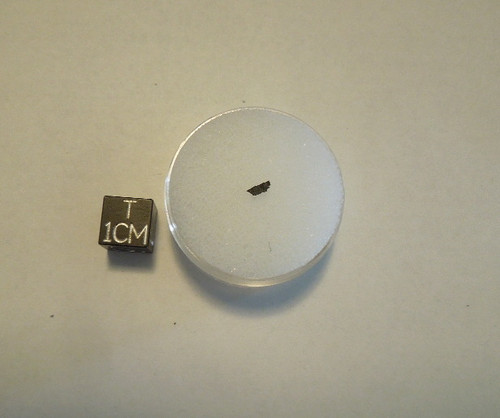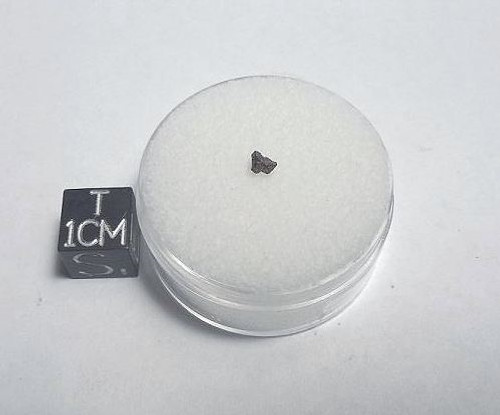NWA 13758 is a rare Rumuruti chondrite (type 3) that was first recovered out of the Algerian Sahara in 2017. This is one of only 77 known R3 meteorites. It is loaded with tiny chondrules.
Refer to the photo. The black centimeter cube is shown for scale and is not included. You are purchasing a small fragment like the one shown. Your purchase will include a labeled gemjar.
From the Meteoritical Bulletin entry on NWA 13758 :
Northwest Africa 13758 (NWA 13758)
Adrar, Algeria
Purchased: 2017
Classification: Rumuruti chondrite (R3)
History: A large group of identically appearing stones, found together, was purchased by a Saharan dealer from a nomad in Algeria. The original find was reportedly in the Tanezrouft Plateau, with the nearest town being Reggane, Algeria.
Physical characteristics: Approximately 500 pieces ranging in mass from <1 kg to >5 kg, with a total known weight of approximately 100 kg. Dark brown sandblasted exterior. Saw cut reveals a breccia with fragments up to ~2 cm set in a fine-grained matrix. Abundant distinct chondrules are visible throughout. Two main lithologic domains exist within this meteorite, one has a gray, unstained matrix, and the second has a brownish-orange-stained matrix.
Petrography: (C. Agee, UNM) Chondrite with mean apparent chondrule size 350±240 µm (n=21) set in abundant matrix (~35 vol%). Electron microprobe analyses were performed separately on the two main lithologic domains. Domain "A" has compositionally unequilibrated olivine and pyroxene both in chondrules as well as single mineral fragments in the matrix. Very small grains of albitic plagioclase are present. Chromite, pentlandite, and troilite are ubiquitous. No metal or oxidized iron was detected. Domain "B" has compositionally unequilibrated olivine and pyroxene both in chondrules as well as single mineral fragments in the matrix. Domain "B" appears to have slightly more chondrules than domain "A". Very small grains of albitic plagioclase were present. Ti-rich chromite, pentlandite, and Ni-bearing troilite are ubiquitous. No metal or oxidized iron was detected.
Geochemistry: (C. Agee, UNM) Domain "A": olivine Fa36.6±8.4, CV=23%, Fe/Mn=83±15, n=12; low-Ca pyroxene Fs21.4±6.8Wo0.9±0.5, Fe/Mn=39±19, n=4; augite Fs8.8±0.7Wo46.0±0.2, Fe/Mn=43±4, n=2; plagioclase An8.8±0.6Ab86.5±0.2Or4.7±0.7, n=3. Domain "B": olivine Fa38.7±5.8, CV=15%, Fe/Mn=87±10, n=12; low-Ca pyroxene Fs10.0±7.7Wo2.0±1.8, Fe/Mn=15±7, n=4; augite Fs11.4±0.9Wo44.8±1.3, Fe/Mn=51±11, n=2; plagioclase An9.2±0.9Ab85.9±1.6Or4.9±0.8, n=3.
Classification: Rumuruti chondrite (R3). Domain "A" is approximately R3.7 and domain "B" is approximately R3.9, based on olivine coefficient of variation (CV).





